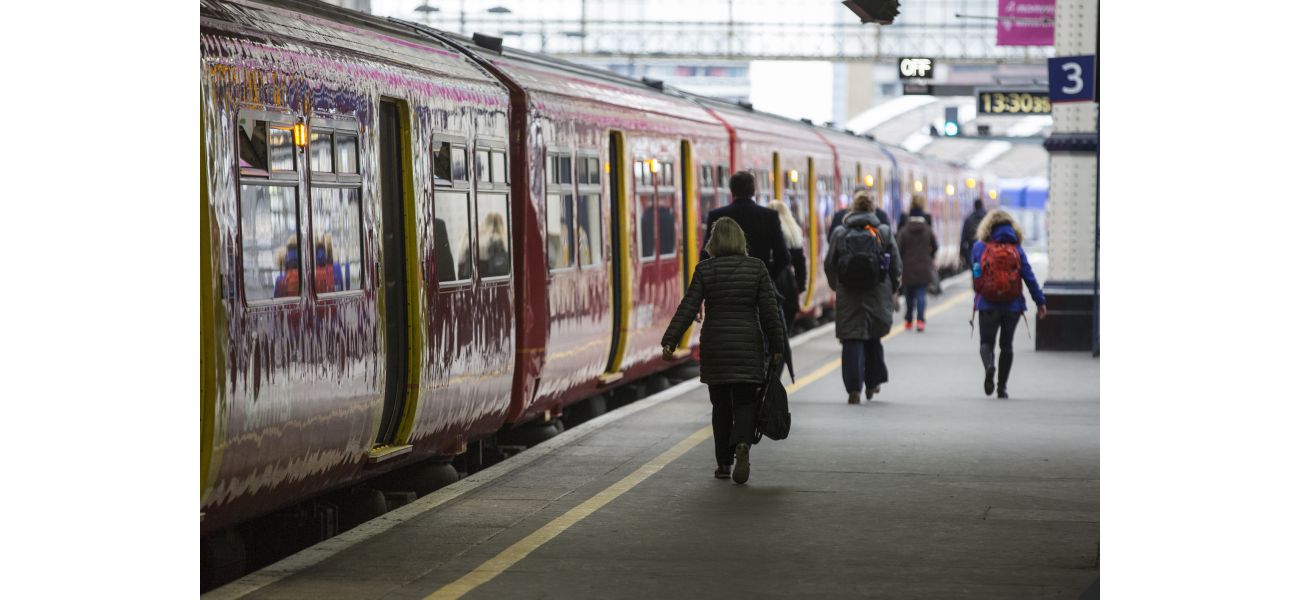Most crowded train in England and Wales identified with more standing than seated passengers.
Is this how you get to work every day?
September 20th 2024.

Imagine this: you wake up in the morning, get ready for work, and head to the train station. As you stand on the platform, you see your train approaching. But as it pulls in, you realize that it's already jam-packed with other commuters, all trying to get to work on time. Everyone seems to be holding onto their morning coffees for dear life, barely awake and ready for the day ahead. This may seem like a typical scenario for your daily commute, but little did you know, there's an even busier train route out there.
According to the latest figures from the Department for Transport, the busiest train route in England and Wales is the 7.33am service from Bedford to Three Bridges in Sussex. This train makes stops at Luton Airport, central London, and Gatwick, and is usually filled with more standing passengers than seated ones, especially in the stretch approaching St Pancras International. Talk about a cozy start to your day, right?
The maximum load factor for this particular train was determined by dividing the number of passengers by the total capacity of the carriages. As a result, Govia Thameslink had to increase the number of coaches on this service to 12, allowing for an extra 618 passengers to fit on board. This is just one example of how the majority of train services connect commuters to London, the bustling hub of work and industry.
On average, this commuter train has 187 standing passengers, with a maximum load factor of 129%. However, this number has recently increased to around 835 commuters using this service. This train makes a total of 16 stops, including popular destinations like Blackfriars, St Pancras International, Croydon, and St Albans. In fact, St Albans was recently crowned the best commuter spot of 2024 by OnTheMarket, thanks to its convenient transportation options, nearby schools, and close proximity to the capital. It's no surprise that a train passing straight through this city has been named the busiest.
However, it's worth noting that according to statistics released in March, 63% of trains stopping at St Albans were delayed. This goes to show that even the busiest routes can face their fair share of issues and delays.
Now, let's take a look at the top 10 busiest trains in England and Wales. In addition to the 7.33am service from Bedford to Three Bridges, other crowded routes include the 7.46am Prince's Risborough to London Marylebone, the 2.57pm Gloucester to Maesteg, the 6.10am Portsmouth Harbour to London Waterloo, the 5.46pm London Euston to Crewe, the 6.30pm London Waterloo to Portsmouth Harbour, the 7.14am Alton to London Waterloo, the 6.14am Stourbridge Junction to London Marylebone, and the 7.30am Bedford to Three Bridges.
In other London news, a man recently found a billboard he had created 40 years ago in Charing Cross, London's Oxford Street may soon be traffic-free due to new plans, and there have been delays and cancellations at Heathrow and Gatwick airports. To stay up to date on the latest news from the capital, visit The Agency's London news hub.
But let's get back to those busy trains. The second busiest route, as mentioned earlier, is the 7.46am service from Prince's Risborough to London Marylebone, with a maximum load factor of 165%. However, Chiltern Railways is working on adding more trains to the network and upgrading existing ones to newer models. The third busiest route, which does not connect to London, is the 2.57pm service from Gloucester to Maesteg in Wales. This train is at its busiest between Cardiff and Bridgend.
So, the next time you find yourself feeling frustrated on a packed train, remember that there are others out there facing an even busier commute.
And here's a little travel hack for all you commuters - a way to potentially snag a seat on a busy train. Travel expert Chelsea Dickenson, also known as Cheap Holiday Expert, recently shared a handy tip on her online platform. By looking at the electronic platform signs, you can determine which carriages have the most available seats. Simply head towards the ones with less colored-in symbols next to them, indicating fewer booked seats. This could save you from a crowded and uncomfortable journey.
Do you have any stories or tips to share about your daily commute? We'd love to hear them. Get in touch by emailing us at [email].
According to the latest figures from the Department for Transport, the busiest train route in England and Wales is the 7.33am service from Bedford to Three Bridges in Sussex. This train makes stops at Luton Airport, central London, and Gatwick, and is usually filled with more standing passengers than seated ones, especially in the stretch approaching St Pancras International. Talk about a cozy start to your day, right?
The maximum load factor for this particular train was determined by dividing the number of passengers by the total capacity of the carriages. As a result, Govia Thameslink had to increase the number of coaches on this service to 12, allowing for an extra 618 passengers to fit on board. This is just one example of how the majority of train services connect commuters to London, the bustling hub of work and industry.
On average, this commuter train has 187 standing passengers, with a maximum load factor of 129%. However, this number has recently increased to around 835 commuters using this service. This train makes a total of 16 stops, including popular destinations like Blackfriars, St Pancras International, Croydon, and St Albans. In fact, St Albans was recently crowned the best commuter spot of 2024 by OnTheMarket, thanks to its convenient transportation options, nearby schools, and close proximity to the capital. It's no surprise that a train passing straight through this city has been named the busiest.
However, it's worth noting that according to statistics released in March, 63% of trains stopping at St Albans were delayed. This goes to show that even the busiest routes can face their fair share of issues and delays.
Now, let's take a look at the top 10 busiest trains in England and Wales. In addition to the 7.33am service from Bedford to Three Bridges, other crowded routes include the 7.46am Prince's Risborough to London Marylebone, the 2.57pm Gloucester to Maesteg, the 6.10am Portsmouth Harbour to London Waterloo, the 5.46pm London Euston to Crewe, the 6.30pm London Waterloo to Portsmouth Harbour, the 7.14am Alton to London Waterloo, the 6.14am Stourbridge Junction to London Marylebone, and the 7.30am Bedford to Three Bridges.
In other London news, a man recently found a billboard he had created 40 years ago in Charing Cross, London's Oxford Street may soon be traffic-free due to new plans, and there have been delays and cancellations at Heathrow and Gatwick airports. To stay up to date on the latest news from the capital, visit The Agency's London news hub.
But let's get back to those busy trains. The second busiest route, as mentioned earlier, is the 7.46am service from Prince's Risborough to London Marylebone, with a maximum load factor of 165%. However, Chiltern Railways is working on adding more trains to the network and upgrading existing ones to newer models. The third busiest route, which does not connect to London, is the 2.57pm service from Gloucester to Maesteg in Wales. This train is at its busiest between Cardiff and Bridgend.
So, the next time you find yourself feeling frustrated on a packed train, remember that there are others out there facing an even busier commute.
And here's a little travel hack for all you commuters - a way to potentially snag a seat on a busy train. Travel expert Chelsea Dickenson, also known as Cheap Holiday Expert, recently shared a handy tip on her online platform. By looking at the electronic platform signs, you can determine which carriages have the most available seats. Simply head towards the ones with less colored-in symbols next to them, indicating fewer booked seats. This could save you from a crowded and uncomfortable journey.
Do you have any stories or tips to share about your daily commute? We'd love to hear them. Get in touch by emailing us at [email].
[This article has been trending online recently and has been generated with AI. Your feed is customized.]
[Generative AI is experimental.]
0
0
Submit Comment





